|
|
|
Sort Order |
|
|
|
Items / Page
|
|
|
|
|
|
|
| Srl | Item |
| 1 |
ID:
099786
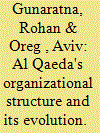

|
|
|
|
|
| Publication |
2010.
|
| Summary/Abstract |
The inner organizational structure of Al Qaeda within the expanded framework of the "Global Jihad movement" has been a subject of much debate between scholars. As will be elaborated later, the "Global Jihad movement" is composed of several elements that possess radical Islamic ideology and conduct operational activity in different regions in the world under the banner of Jihad. The dominant factor within the "Global Jihad movement" is by no doubt Al Qaeda. The purpose of this article is to focus solely on Al Qaeda and present the formal internal structure of the organization. The article argues that Al Qaeda is first and foremost, an infrastructural organization with a formal echelon, hierarchy, sub-departmental division, and duties distribution reflecting characteristics of a guerilla and terrorist organization. The article portrays the formal layout of Al Qaeda, composed of the main command apparatus, and names the different personalities who fill the more important positions within Al Qaeda's hierarchy from its days of inception until today.
|
|
|
|
|
|
|
|
|
|
|
|
|
|
|
|
| 2 |
ID:
140995


|
|
|
|
|
| Summary/Abstract |
Since the early 2000s, the Government of Japan has undertaken intensive efforts to reform its Intelligence Community (IC) in response to recent rapid changes of the national security environment surrounding Japan, such as increasing threats of terrorism, and North Korea's missile and nuclear programs, among others. The major objectives have been: (1) establishing an effective institutional mechanism connecting policymakers and the IC and (2) improving intelligence collection capabilities.
|
|
|
|
|
|
|
|
|
|
|
|
|
|
|
|
| 3 |
ID:
086597
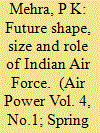

|
|
|
|
|
| Publication |
2009.
|
| Summary/Abstract |
The process of assessing the future, shape and role of the Indian Air Force, according to Air Marshal P.K. Mehra, PVSM, AVSM VM (Retd), like that of assessing for other air forces, is a complex one, with enormous imponderables and, above all, the challenge of assessing the changes that may come about in the hostile air forces. The long gestation period in making changes itself requires sufficient flexibility to be built into even the most scientific and empirically sound model. Above all, this is a process that has to be adequately addressed by decision-makers in developing democracies who are normally far more deeply focussed on current problems rather than long-term planning and investment of resources in military, especially aerospace, capabilities for defence.
|
|
|
|
|
|
|
|
|
|
|
|
|
|
|
|
| 4 |
ID:
152886
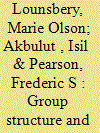

|
|
|
|
|
| Summary/Abstract |
Studies have begun to look at the potentially crucial impacts of group decentralization and inter-group global networking in accounting for the extent and severity of violence in insurgencies and terrorism. Groups may be able to survive more effectively, evade anti-terror or counter-insurgency strategies, and inflict greater damage or more civilian attacks by operating under more or less centralized leadership, or by making use of the resources of other like-minded groups scattered across borders. While some analysts have examined each of these possibilities, few if any have done so simultaneously with both structural and networking indicators or examined the joint effects of these indicators. We propose to do so in this study by combining existing datasets on terrorist structure and networks. Hypotheses and findings in prior studies have indicated that structural decentralization may lead to more civilian attacks if not more destruction since local cells are freer to act on their own, and that group size and centrality in the global terror networks lead to greater lethality and group survival rates. We re-examine such assumptions here with OLS and logit models combining these effects, and find that in addition to group size, network reach (eigenvalue centrality) rather than group interconnections per se (number of allies) appears to have primary impacts on group lethality, targeting, and survival, sometimes in conjunction with decentralized organizational structure.
|
|
|
|
|
|
|
|
|
|
|
|
|
|
|
|
| 5 |
ID:
154925
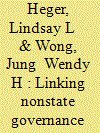

|
|
|
|
|
| Summary/Abstract |
Too often, our analyses of nonstate violent groups tend to black box the other aspects of what such groups do. Some groups choose to provide governance (in the form of goods of services) in addition to coordinating violence to achieve political goals. These different kinds of functions, whether violent or not, are all tied to the same underlying organizational structure. From this basic insight, we argue that groups that pursue both governance and violence will tend to have the following organizational structure: clear organizational agenda setting, command and control, and accountability mechanisms. This organizational structure will tend to produce a unique violence profile and allow for the provision of governance. In short, we point out the double-edged sword of organizational structure in terms of the outcomes that groups produce. Using several datasets, including the new Terrorist and Insurgent Organization Social Services dataset that accounts for the provision of social services, we show a preliminary association between violence and governance that demands future exploration. Thus, as a theory-building effort, our work demonstrates the importance of accounting for the diversity of activities that violent groups might pursue and offers evidence for how organizational structure shapes the possibility of pursuing different activities.
|
|
|
|
|
|
|
|
|
|
|
|
|
|
|
|
| 6 |
ID:
132504


|
|
|
|
|
| Publication |
2014.
|
| Summary/Abstract |
The world is a vulnerable place. It is vulnerable to a "long list of disasters that natureisfury unleashes from time to time to remind us of our mortal and transitory presence on this planet. Planet Earth, were she 'to voice her opinion, and if someone were prepared to listen, may be tempted to add even man to this long list of disasters she has to endure. " '
|
|
|
|
|
|
|
|
|
|
|
|
|
|
|
|
| 7 |
ID:
177819
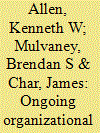

|
|
|
|
|
| Summary/Abstract |
Since the Chinese Communist Party’s (CCP) Central Military Commission launched a major reorganization of the entire People’s Liberation Army (PLA) in early 2016, the PLA Air Force (PLAAF) has followed up with its own reforms at all levels. In February 2016, the changes entailed ‘above the neck’ reforms at PLAAF Headquarters and reduced the number of Military Region Air Force Headquarters from 7 to 5, renaming them Theatre Command Air Forces. Changes in 2017 focused on ‘below the neck’ reforms by creating a ‘base-brigade’ structure by reforming several command posts into bases; abolishing fighter, fighter-bomber, and ground attack aircraft air divisions; replacing air regiments with brigades; as well as changing the name of its former 15th Airborne Corps to Airborne Corps. Whilst the PLA leadership has moved ahead with pushing the PLAAF towards becoming a modern air force with enhanced aerial power alongside greater interoperability with the other PLA services, the reconstitution of its organizations has nevertheless led to a fallout due to policy changes concerning its rank-and-file.
|
|
|
|
|
|
|
|
|
|
|
|
|
|
|
|
| 8 |
ID:
153752


|
|
|
|
|
| Summary/Abstract |
The authors carry out a retrospective analysis of the evolutionary process in organizational structures of forces charged with armed struggle in airspace (aerospace). They uncover the causes that significantly influenced the evolution of organizational forms in formations within the Air Defense Forces, Air Force, Aerospace Defense Forces and Aerospace Forces.
|
|
|
|
|
|
|
|
|
|
|
|
|
|
|
|
| 9 |
ID:
112615
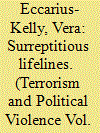

|
|
|
|
|
| Publication |
2012.
|
| Summary/Abstract |
The Armed Revolutionary Forces of Columbia (FARC) and Kurdistan Workers Party (PKK) have both demonstrated an uncanny ability to transform themselves and adapt to changing environmental conditions. Integral to the groups are webbed criminal enterprises, cross-border sanctuaries, and internationally-oriented advocacy networks. Both organizations avoided catastrophic breakdowns through a combination of organic survival mechanisms and precise organizational restructuring. Since 2008, the FARC moved away from a centralized wheel structure model toward a system of multiple decision-making nodes. Guerrilla units now operate in an atomized manner since they are often disconnected from the central leadership. This encouraged a growing number of FARC commanders to focus on narco-profits rather than the organization's ideological goals. Meanwhile, the PKK functions in an octopus-like manner, extending its tentacles into neighboring countries and Europe. However, the process of democratization in Turkey and improved international law enforcement collaboration increased internal as well as external pressure on the PKK to restructure. As a result the PKK is struggling to keep its far-reaching tentacles coordinated. The PKK misjudged its ability to manage political groups which weakened its ideological grip, yet the organization's control over criminal and guerrilla branches continues to be as fierce as ever. The FARC's and the PKK's organizational changes suggest that security agencies in Colombia and Turkey need to adapt their counterterrorism strategies also.
|
|
|
|
|
|
|
|
|
|
|
|
|
|
|
|
| 10 |
ID:
143898


|
|
|
|
|
| Summary/Abstract |
A turning points analysis is used to capture the negotiating dynamics that occur within the structure of the GATT and the WTO. Ministerial/Council-level operations and Committee-level operations are distinguished. Within WTO Doha Development Agenda negotiations (2001–present), we isolate Ministerial/Council-level data and within GATT, we isolate Committee-level data by examining Trade Related Aspects of Intellectual Property Rights negotiations conducted during the GATT Uruguay round (1985–1994) and at the WTO Doha Ministerial (2001). A detailed chronology of each case is compiled, followed by the identification of precipitants, departures and consequences, which are the three parts of a turning points analysis. We conclude that the precipitants that led to negotiation turning points in the Ministerial/Council environment are exclusively internal and generally procedural. The precipitants creating turning points within the Committee environment are generally internal and substantive. These conclusions have implications for our understanding of international environments and their impact on negotiation process.
|
|
|
|
|
|
|
|
|
|
|
|
|
|
|
|
|
|
|
|
|